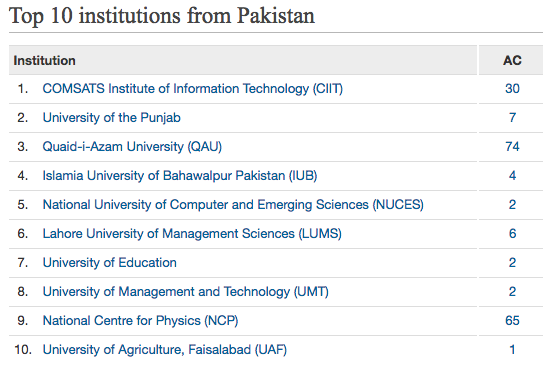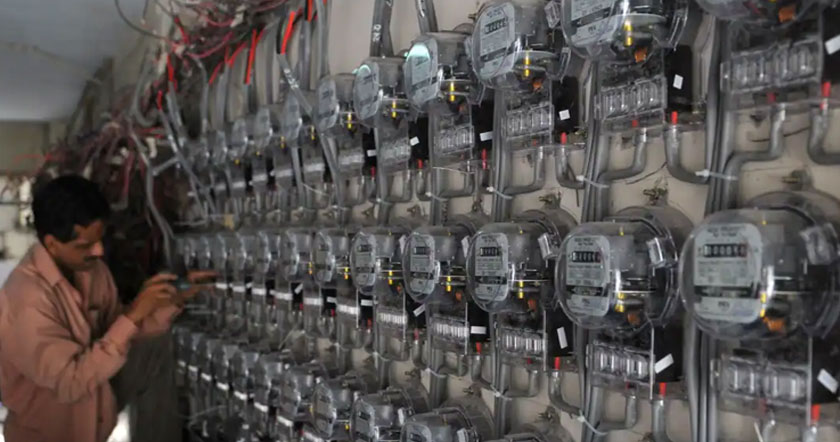Pakistan's quality-adjusted scientific output (Weighted Functional Count) as reported in Nature Index has doubled from 18.03 in 2013 to 37.28 in 2017. Pakistan's global ranking has improved from 53 in 2013 to 40 in 2017. In the same period, India's WFC has increased from 850.97 in 2013 to 935.44 in 2017. India's global ranking has improved from 13 in 2013 to 11 in 2017.

Top 10 Pakistan Institutions in Scientific Output. Source: Nature Index
Pakistan's Global Ranking:
Pakistan ranks 40 among 161 countries for quality adjusted scientific output for year 2017 as reported by Nature Index 2018. Pakistan ranks 40 with quality-adjusted scientific output of 37.28. India ranks 11 with 935. Malaysia ranks 61 with 6.73 and Indonesia ranks 63 with 6.41. Bangladesh ranks 100 with 0.81. Sri Lanka ranks 84 with 1.36. US leads with almost 15,800, followed by China's 7,500, Germany 3,800, UK 3,100 and Japan 2,700.
Nature Index:
The Nature Index is a database of author affiliation information collated from research articles published in an independently selected group of 82 high-quality science journals. The database is compiled by Nature Research. The Nature Index provides a close to real-time proxy of high-quality research output and collaboration at the institutional, national and regional level.
The Nature Index includes primary research articles published in a group of high-quality science journals. The journals included in the Nature Index are selected by a panel of active scientists, independently of Nature Research. The selection process reflects researchers’ perceptions of journal quality, rather than using quantitative measures such as Impact Factor. It is intended that the list of journals amounts to a reasonably consensual upper echelon of journals in the natural sciences and includes both multidisciplinary journals and some of the most highly selective journals within the main disciplines of the natural sciences. The journals included in the Nature Index represent less than 1% of the journals covering natural sciences in the Web of Science (Clarivate Analytics) but account for close to 30% of total citations to natural science journals.
Pakistan vs BRICS:
In a report titled "Pakistan: Another BRIC in the Wall", author Lulian Herciu says that Pakistan’s scientific productivity has quadrupled, from approximately 2,000 articles per year in 2006 to more than 9,000 articles in 2015. During this time, the number of Highly Cited Papers featuring Pakistan-based authors increased tenfold, from 9 articles in 2006 to 98 in 2015.
Top Asian Universities:
British ranking agency Quacquarelli Symonds (QS) has recently ranked 23 Pakistani universities among the top 500 Asian universities for 2019, up from 16 in 2018. Other South Asian universities figuring in the QS top universities report are 75 from India, 6 from Bangladesh and 4 from Sri Lanka.
In terms of the number of universities ranking in Asia's top 500, Pakistan with its 23 universities ranks second in South Asia and 7th among 17 Asian nations topped by China with 112, Japan 89, India 75, South Korea 57, Taiwan 36, Malaysia 26, Pakistan 23, Indonesia 22, Thailand 19, Philippines 8, Hong Kong 7, Vietnam 7, Bangladesh 6, Sri Lanka 4, Singapore 3, Macao 2 and Brunei 2.
Summary:
Pakistan's quality-adjusted scientific output (WFC) as reported in Nature Index has doubled from 18.03 in 2013 to 37.28 in 2017. Pakistan's global ranking has improved from 53 in 2013 to 40 in 2017. Pakistan ranks 40 with quality-adjusted scientific output of 37.28. India ranks 11 with 935. Malaysia ranks 61 with 6.73 and Indonesia ranks 63 with 6.41. Bangladesh ranks 100 with 0.81. Sri Lanka ranks 84 with 1.36. In a report titled "Pakistan: Another BRIC in the Wall", author Lulian Herciu says that Pakistan’s scientific productivity has quadrupled, from approximately 2,000 articles per year in 2006 to more than 9,000 articles in 2015. During this time, the number of Highly Cited Papers featuring Pakistan-based authors increased tenfold, from 9 articles in 2006 to 98 in 2015. British ranking agency Quacquarelli Symonds (QS) has recently ranked 23 Pakistani universities among the top 500 Asian universities for 2019, up from 16 in 2018.
http://www.riazhaq.com/2018/11/pakistans-scientific-output-doubles-in.html


































